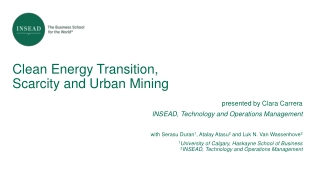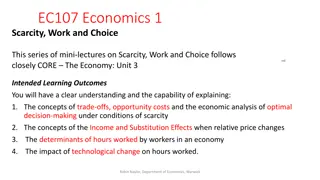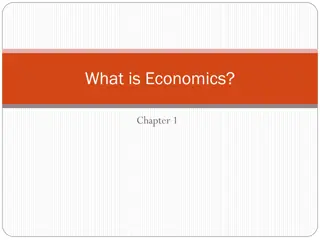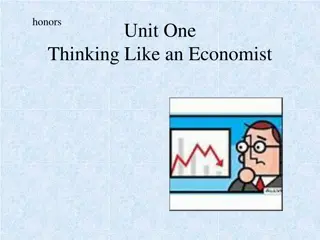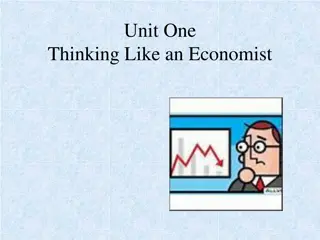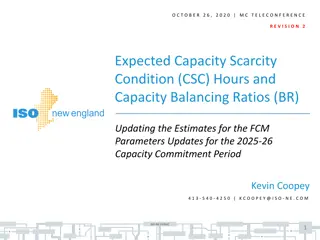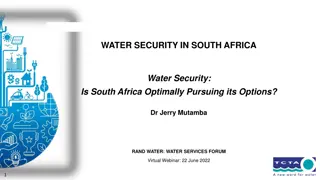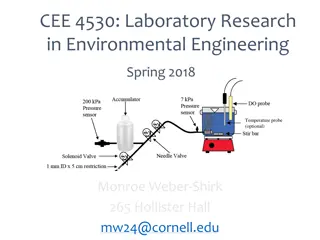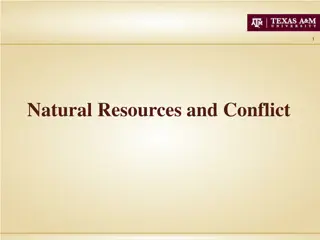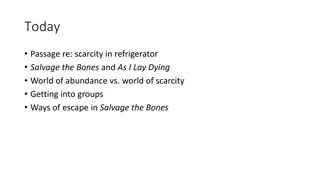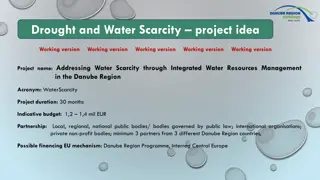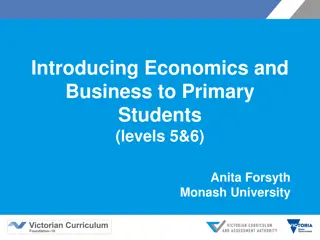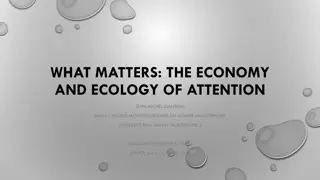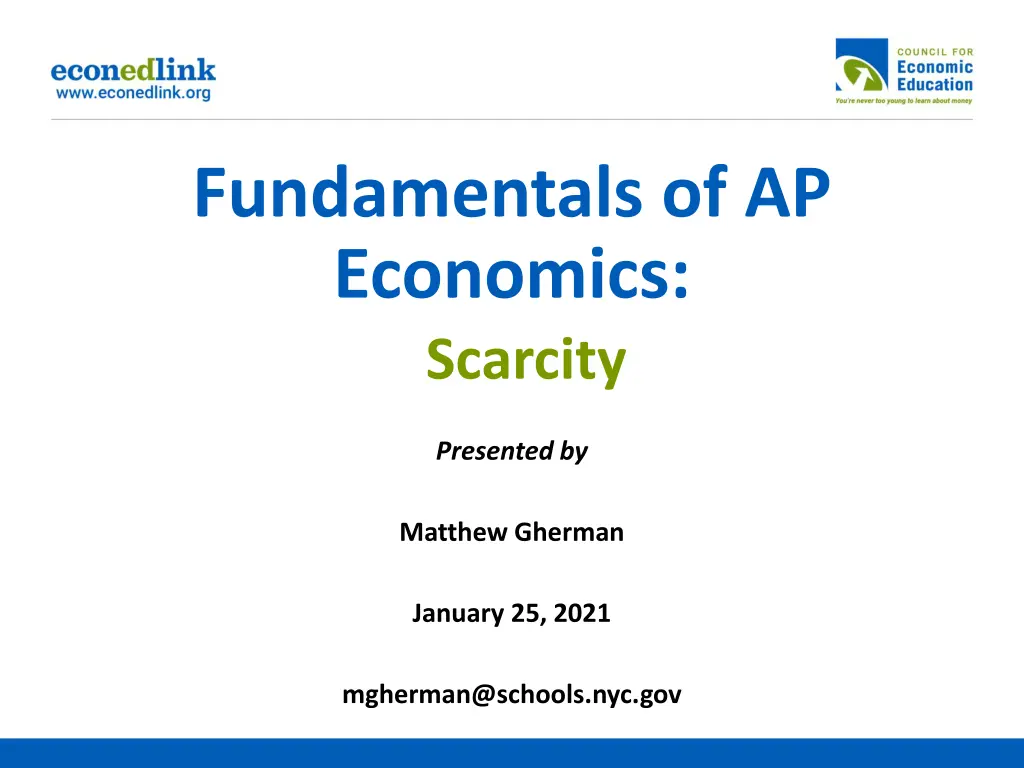
Understanding AP Economics: Scarcity & Economic Systems
Explore the fundamentals of AP Economics through a comprehensive webinar presented by Matthew Gherman. Learn about scarcity, economic systems, and societal challenges. Access professional development resources and earn certificates. Dive into topics like behavioral science, assessment, and national standards in economics education.
Download Presentation

Please find below an Image/Link to download the presentation.
The content on the website is provided AS IS for your information and personal use only. It may not be sold, licensed, or shared on other websites without obtaining consent from the author. If you encounter any issues during the download, it is possible that the publisher has removed the file from their server.
You are allowed to download the files provided on this website for personal or commercial use, subject to the condition that they are used lawfully. All files are the property of their respective owners.
The content on the website is provided AS IS for your information and personal use only. It may not be sold, licensed, or shared on other websites without obtaining consent from the author.
E N D
Presentation Transcript
Fundamentals of AP Economics: Scarcity Presented by Matthew Gherman January 25, 2021 mgherman@schools.nyc.gov
EconEdLink Membership You can now access CEE s professional development webinars directly on EconEdLink.org! To receive these new professional development benefits, become an EconEdLink member. As a member, you will now be able to: Automatically receive a professional development certificate via e-mail within 24 hours after viewing any webinar for a minimum of 45 minutes Register for upcoming webinars with a simple one-click process Easily download presentations, lesson plan materials and activities for each webinar Search and view all webinars at your convenience Save webinars to your EconEdLink dashboard for easy access to the event You may access our new Professional Development page here
Professional Development Certificate To earn your professional development certificate for this webinar, you must: Watch a minimum of 45-minutes and you will automatically receive a professional development certificate via e-mail within 24 hours. Accessing resources: You can now easily download presentations, lesson plan materials, and activities for each webinar from EconEdLink.org/professional-development/
Agenda Initial lessons lessons of the AP Economics Curriculum Activities Activities to build understanding of AP Economics as a Behavioral Science Assessment Assessment Questions
Objectives Understanding Why economics is the study of scarcity The challenges scarcity creates for societies How societies create economic systems to answer the fundamental economic questions
National Standards 1.1. Choices made by individuals, firms, or government officials are constrained by the resources to which they have access. 1.2. Choices made by individuals, firms, or government officials often have long run unintended consequences that can partially or entirely offset or supplement the initial effects of the decision.
State Standards 4.1: analyze the effectiveness of varying ways societies, nations, and regions of the world attempt to satisfy their basic needs and wants by utilizing scarce resources 4.1: understand the nature of scarcity and how nations of the world make choices which involve economic and social costs and benefits 4.1: describe the ideals, principles, structure, practices, accomplishments, and problems related to the United States economic system
Group Activity: Concept Introduction Instructions: must decide which patients should receive kidney transplants as donated organs become available. Recently, the hospital received an organ donation from the family of an accident victim. You have five potential candidates for the transplant. As best as your team can determine, each of the five candidates bodies would accept the kidney without major threat of rejection. The cost of the operation, surgical fees and hospital care comes to approximately $150,000. You are members of the surgical team at New York Hospital. As a team, you Your job is to: 1) Decide which patient will receive the kidney transplant 2) Decide what criteria you will use to evaluate each patient and arrive at your final decision 3) Acknowledge what you lose/give up by picking your choice
Economics is the study of scarcity. How societies deal with the enduring issue of unlimited wants vs. limited resources Needs vs. wants Micro vs. Macro: small-scale individual units vs. wholistic economy and nation-wide economic issues Positive vs. normative economics: Normative: opinion Positive: scientific method Class Discussion: To what extent are cell phones a Class Discussion: To what extent are cell phones a need or a want? need or a want?
Group Activity: Island Survival Instructions: In this activity, you will assume the role of a crew member of a damaged sailing vessel, stranded on a deserted island. You hope to be rescued but must plan for survival. 1) You will have 25 minutes to read the scenario and as a group answer all 3 of the questions 2) You are trying to survive and not escape! 3) Keep in mind that you will be creating an economics system, and as you do, you will be answering the fundamental questions that all economic systems have to address. Think about what those questions might be as you are doing the activity.
I. Factors of Production = Ingredients that go into making good and services. Class Discussion: - What do you think each is? Give examples. Goods tangible can feel them (hat, car) Services intangible act (haircut, carwash) Types of Resources/Factors of Production Natural Resources: A factor of production obtained from the land, sea or air (from nature). sunlight, animals) a. Renewable Resources: Can be replaced/renewed (trees, consumed, they are gone forever (oil, minerals) b. Non-Renewable Resources: resources that once they are
II. Human Resources = Human labor/workforce. Class Discussion: - Why do wages differ for different types of labor? Explain - Do you disagree with the concept of a higher minimum wage? Explain. How Humans Increase Productivity increase skills increase quality and quantity of machinery and tools available technology
III. Capital Resources = Machines, tools, buildings and other technology used to produce goods and services. Class Discussion: - What are some examples of capital goods depreciating in your lifetime? (Depreciation: the losing of value/deterioration.) AP Eco Note Investment spending refers to businesses spending on capital resources
IV. Entrepreneurship/Management = Person with the goal of creating and operating a business. The process of bringing together the first three factors of production. Class Discussion: - Is it better for society if individuals privately control the factors of production, or if the government controls the factors of production? Explain. Goals of An Entrepreneur Introduces new products and technology, improves management techniques, invests time and money in hope of earning a profit
#1 What will be produced? Businesses and government can only produce a certain number of goods by producing less of another. #2 How should goods and services be produced? Management must decide how to use the factors of production in the most efficient way possible. #3 How will resources be allocated/who should receive the goods and services? Since it is not possible to produce enough of everything, who should be allowed to have it. Also leads us to price and cost of a good or service. #4 Who makes the decisions/controls the resources? Class Discussion: Which of these do you think is the most important question? How does the United States (socially, politically, historically) answer each question?
Activities: Read the brief description of each economic system Complete the Graphic Organizer activity sheet for each economic system Funny video: https://www.youtube.com/watch?v=QwqnRYPcrl0 Have students write pros/cons of each as they watch the video
Introduction: What are the fundamental differences between street and highway highway driving? street driving Pillars of Capitalism: The institutions and practices that make capitalism function Activity: Building Blocks of Capitalism handout
What other pillars might we need? Government as a referee, legal system to uphold contracts, prevent monopolies, etc. Price Systems
1. Act as Signals to Buyers and Sellers- When prices are low enough, they send a "buy" signal to buyers (consumers), who can now afford the things they want. When prices are high enough, they send a "sell" signal to sellers (retailers), who can now earn a profit at the new price. 2. Encourage Efficient Production- Prices encourage business people to produce their goods the most efficient way possible, to create the lowest cost possible. The less it costs to produce an item, the more likely it is that its producers will earn a profit. 3. Determine Who Will Receive the Things Produced- Finally, prices help to determine who will receive the economy's output of goods and services. The price that a worker receives for doing a job is called a wage. The amount of this wage determines how much the worker has to spend. What the worker can buy with those wages will depend, in turn, upon the prices of the goods and services the worker would like to own.
Circular Flow Model Activity Sheet The Players of the Circular Flow Model: Household sector: This includes all people seeking to satisfy unlimited wants and needs. This sector is responsible for consumption. Business sector: This includes those undertaking the task of combining resources to produce goods and services. This sector is responsible for production. Government sector: This includes the ruling bodies of the federal, state, and local governments, especially to pass laws, collect taxes, and force other economic sectors to do things that they wouldn't do voluntarily. This sector is responsible for regulation.
Political Scorecard: Political Scorecard: fiscal powers (spending and taxing) to start the flow of the dollar, should it start in the product market, with helping households spend? Or in the factor market, with helping businesses to hire people, expand and produce? Where does the flow of the dollar start? If the government can use its
CEE Affiliates https://www.councilforeconed.org/resources/local-affiliates/

